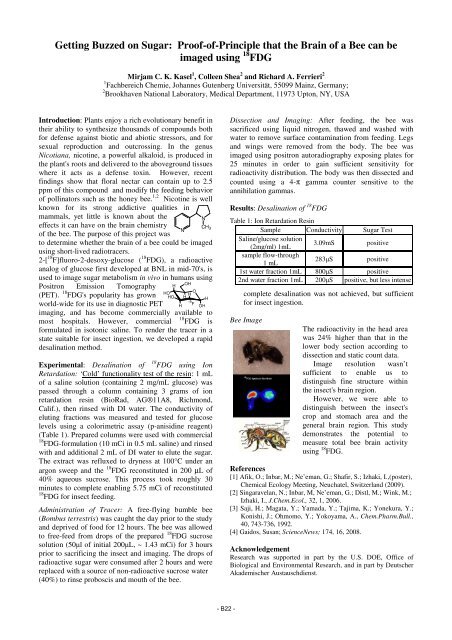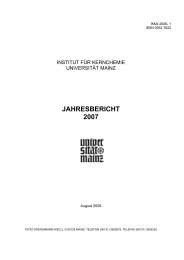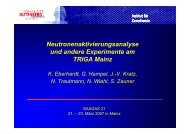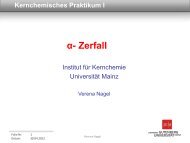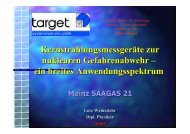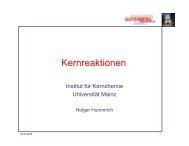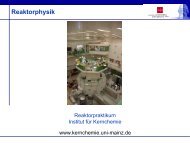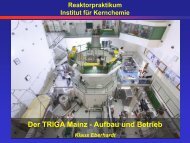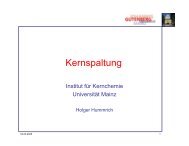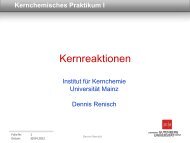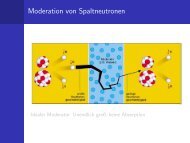institut für kernchemie universität mainz jahresbericht 2009
institut für kernchemie universität mainz jahresbericht 2009
institut für kernchemie universität mainz jahresbericht 2009
Create successful ePaper yourself
Turn your PDF publications into a flip-book with our unique Google optimized e-Paper software.
Getting Buzzed on Sugar: Proof-of-Principle that the Brain of a Bee can be<br />
imaged using 18 FDG<br />
Mirjam C. K. Kasel 1 , Colleen Shea 2 and Richard A. Ferrieri 2<br />
1 Fachbereich Chemie, Johannes Gutenberg Universität, 55099 Mainz, Germany;<br />
2 Brookhaven National Laboratory, Medical Department, 11973 Upton, NY, USA<br />
Introduction: Plants enjoy a rich evolutionary benefit in<br />
their ability to synthesize thousands of compounds both<br />
for defense against biotic and abiotic stressors, and for<br />
sexual reproduction and outcrossing. In the genus<br />
Nicotiana, nicotine, a powerful alkaloid, is produced in<br />
the plant's roots and delivered to the aboveground tissues<br />
where it acts as a defense toxin. However, recent<br />
findings show that floral nectar can contain up to 2.5<br />
ppm of this compound and modify the feeding behavior<br />
of pollinators such as the honey bee. 1,2 Nicotine is well<br />
known for its strong addictive qualities in<br />
mammals, yet little is known about the<br />
effects it can have on the brain chemistry<br />
of the bee. The purpose of this project was<br />
N<br />
N<br />
CH3<br />
to determine whether the brain of a bee could be imaged<br />
using short-lived radiotracers.<br />
2-[ 18 F]fluoro-2-desoxy-glucose ( 18 FDG), a radioactive<br />
analog of glucose first developed at BNL in mid-70's, is<br />
used to image sugar metabolism in vivo in humans using<br />
H<br />
OH<br />
Positron Emission Tomography<br />
HO<br />
O<br />
(PET). H<br />
HO<br />
H H<br />
18<br />
H<br />
F<br />
OH<br />
18 FDG's popularity has grown<br />
world-wide for its use in diagnostic PET<br />
imaging, and has become commercially available to<br />
most hospitals. However, commercial<br />
18 FDG is<br />
formulated in isotonic saline. To render the tracer in a<br />
state suitable for insect ingestion, we developed a rapid<br />
desalination method.<br />
18<br />
Experimental: Desalination of FDG using Ion<br />
Retardation: ‘Cold’ functionality test of the resin: 1 mL<br />
of a saline solution (containing 2 mg/mL glucose) was<br />
passed through a column containing 3 grams of ion<br />
retardation resin (BioRad, AG®11A8, Richmond,<br />
Calif.), then rinsed with DI water. The conductivity of<br />
eluting fractions was measured and tested for glucose<br />
levels using a colorimetric assay (p-anisidine reagent)<br />
(Table 1). Prepared columns were used with commercial<br />
18<br />
FDG-formulation (10 mCi in 0.5 mL saline) and rinsed<br />
with and additional 2 mL of DI water to elute the sugar.<br />
The extract was refluxed to dryness at 100°C under an<br />
argon sweep and the 18 FDG reconstituted in 200 µL of<br />
40% aqueous sucrose. This process took roughly 30<br />
minutes to complete enabling 5.75 mCi of reconstituted<br />
18<br />
FDG for insect feeding.<br />
Administration of Tracer: A free-flying bumble bee<br />
(Bombus terrestris) was caught the day prior to the study<br />
and deprived of food for 12 hours. The bee was allowed<br />
to free-feed from drops of the prepared 18 FDG sucrose<br />
solution (50µl of initial 200µL, ~ 1.43 mCi) for 3 hours<br />
prior to sacrificing the insect and imaging. The drops of<br />
radioactive sugar were consumed after 2 hours and were<br />
replaced with a source of non-radioactive sucrose water<br />
(40%) to rinse proboscis and mouth of the bee.<br />
- B22 -<br />
Dissection and Imaging: After feeding, the bee was<br />
sacrificed using liquid nitrogen, thawed and washed with<br />
water to remove surface contamination from feeding. Legs<br />
and wings were removed from the body. The bee was<br />
imaged using positron autoradiography exposing plates for<br />
25 minutes in order to gain sufficient sensitivity for<br />
radioactivity distribution. The body was then dissected and<br />
counted using a 4-π gamma counter sensitive to the<br />
annihilation gammas.<br />
Results: Desalination of 18 FDG<br />
Table 1: Ion Retardation Resin<br />
Sample Conductivity Sugar Test<br />
Saline/glucose solution<br />
(2mg/ml) 1mL<br />
3.09mS positive<br />
sample flow-through<br />
1 mL<br />
283µS positive<br />
1st water fraction 1mL 800µS positive<br />
2nd water fraction 1mL 200µS positive, but less intense<br />
complete desalination was not achieved, but sufficient<br />
for insect ingestion.<br />
Bee Image<br />
The radioactivity in the head area<br />
was 24% higher than that in the<br />
lower body section according to<br />
dissection and static count data.<br />
Image resolution wasn’t<br />
sufficient to enable us to<br />
distinguish fine structure within<br />
the insect's brain region.<br />
However, we were able to<br />
distinguish between the insect's<br />
crop and stomach area and the<br />
general brain region. This study<br />
demonstrates the potential to<br />
measure total bee brain activity<br />
using 18 FDG.<br />
References<br />
[1] Afik, O.; Inbar, M.; Ne’eman, G.; Shafir, S.; Izhaki, I.,(poster),<br />
Chemical Ecology Meeting, Neuchatel, Switzerland (<strong>2009</strong>).<br />
[2] Singaravelan, N.; Inbar, M, Ne’eman, G.; Distl, M.; Wink, M.;<br />
Izhaki, I., J.Chem.Ecol., 32, 1, 2006.<br />
[3] Saji, H.; Magata, Y.; Yamada, Y.; Tajima, K.; Yonekura, Y.;<br />
Konishi, J.; Ohmomo, Y.; Yokoyama, A., Chem.Pharm.Bull.,<br />
40, 743-736, 1992.<br />
[4] Gaidos, Susan; ScienceNews; 174, 16, 2008.<br />
Acknowledgement<br />
Research was supported in part by the U.S. DOE, Office of<br />
Biological and Environmental Research, and in part by Deutscher<br />
Akademischer Austauschdienst.


